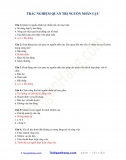Thông tin tài liệu
Waves and persistence in M&A
1 Introduction Empirical evidence on the time series structure of aggregate merger and acquisition (M&A) activity in the U.S. economy has attracted considerable attention in the literature. The question that frequently arises is whether merger activity occurs in EwavesF, that is, whether there are oscillations between low and high levels of merger activity. The answer to this question is important both in forecasting M&A activity and in developing structural models of its stochastic behavior. Recent researchhas made signiGcant progress in deGning EwavesF and econometrically estimating the wave-like behavior in merger activity. The Grst formal testing of the merger wave hypothesis models aggregate merger activity as a two-state Markovswitching-regime model (Town, 1992). In this statistical framework, a merger wave is deGned as a large, discrete increase in the mean of the series. Wave-like M&A activity is consequently modeled as a combination of two AR processes withdiffering means with the transition from a high-wave (high-mean) state to a low-wave (low-mean) state based upon some probability law. Town Gnds that such a model Gts M&A time series behavior well, thus supporting the wave hypothesis. Golbe and White (1993) provide a second direct test of merger wave behavior based on sine-curve estimations for the M&A time series. They Gnd that the coefficient estimate for the amplitude of the sine wave, which is the critical parameter for the wave hypothesis, is statistically signiGcant, and thus conclude that the Gtted model adequately describes the temporal patterns of aggregate merger activity. They hypothesize a cycle length for merger activity of about forty years based upon the value of the coefficient estimate for the period of the wave. Contrary to Golbe and WhiteJs model, merger activity exhibits stretches of high and low values with no obvious hidden or strict periodicity. These temporal patterns of cyclic but nonperiodic behavior appear to be distinct phenomena that embody essential aspects of the data. We argue that this tendency to observe groups of high or low values in merger
Xem thêm


 ThiNganHang Sách - Tài liệu thi tuyển
ThiNganHang Sách - Tài liệu thi tuyển









